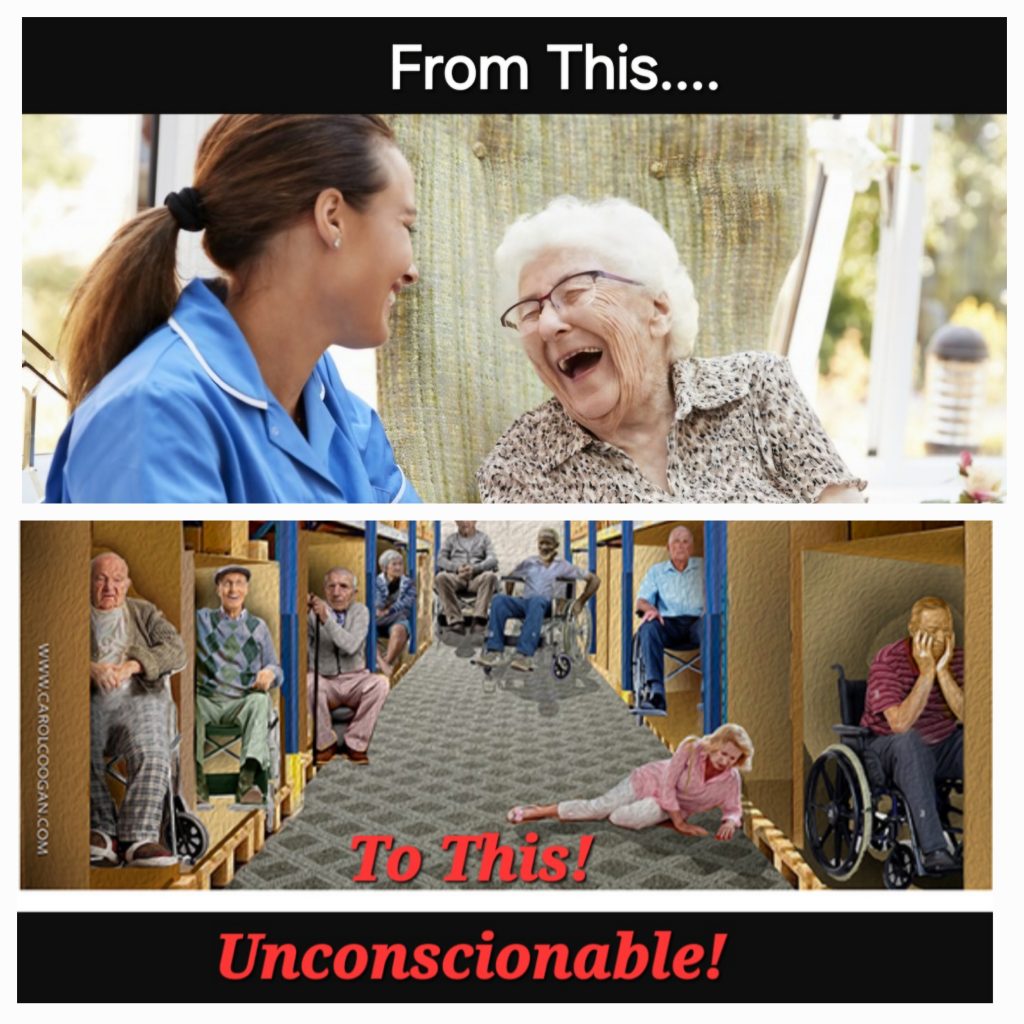
If you need a skilled nursing facility for yourself or a loved one, what’s your next step? Where do you look? This kind of information is online these days. But what you may not find online is what to avoid.
First, do NOT buy into a Life Plan Community or any retirement community that requires a large, non-refundable entrance fee in return for a promise of life care. Over the course of those years, which varies from one facility to another, too much can change that you have zero control over. In other words, you may need that entrance fee. But you’ve already poured hundreds of thousands of dollars into the facility and if you move, you forfeit that money, without ever receiving the care you were promised.
A family at the Gardens faced a difficult decision. Their mom had both medical and memory issues. At the time the Gardens offered skilled nursing and memory care, but they were separate types of care units and the family had to choose one or the other. The family raised issues about this. There was all the money their mom had spent moving into the Gardens and now she needed to choose the medical care and the family would have to hire a private duty caregiver to provide for her memory care needs.
The response from the Nursing Administrator says it all. “Your mom can always move if you aren’t happy.” Sure. Think about that. You sign up and pay for lifetime care – hundreds of thousands of dollars. But once they have your money, they don’t have any incentive to work with your family about your loved one.
Continuing Care/Life Plan Community for a loved one? Just Say NO!
Second, if your loved one must go to a skilled nursing facility after a hospital stay, do not leave them alone. If at all possible, have family and/or friends stay with your loved one around the clock, working in six to eight hour shifts. You may be able to leave from the time your loved one falls asleep to 7 a.m. the next morning. If you belong to a church, members may be able to help cover shifts. Years ago I belonged to a Quaker Meeting, and when one of our members had to stay in a skilled nursing facility, I participated in the shifts. You become an extra pair of eyes, a protector against abuse and neglect.
At the Gardens, they neglected and abused Helen right in front of me. When I brought this up with the Charge Nurse, she simply shrugged her shoulders like it was no big deal. And to them, it wasn’t. They had Helen’s money and it was now completely nonrefundable. Inexplicably it also wasn’t any big deal for LA County or the California Department of Public Health. Their investigations were shoddy and incomplete and Medicare never checked up on the complaint investigations. Instead, they just rubber stamped 5-Stars on the Gardens rating on their website!
If you rely on Medicare ratings about skilled nursing facilities you do so at your own peril or at the peril of a loved one. At one time the Gardens had a long-term CEO committed to the care of his residents, which rightfully earned a 5-Star rating. In the decade since he retired, there have been three CEOs and the care is now abysmal. But their 5-Star rating, now a brand only, is protected by untrue narratives, intimidating letters from the godfather of Senior Living Operators to silence residents who raise concerns, coercion to sign draconian nondisclosure/non-disparagement agreements etc. Anything to protect their Brand.
Medicare covers 100% of skilled nursing for 20 days, and from Day 21 to 100, you pay $204 per day. On day 101 and beyond, you pay all costs until you begin a new benefit period. See Medicare coverage for Skilled Nursing Facility car
Some skilled nursing facilities, like the one at the Gardens, provide three meals day as well as snacks, cleaning, laundry services and social activities. However, I also noticed residents sitting/sleeping in their wheelchairs in corridors during the day and that often felt like neglect. CNAs – certified nursing assistants – assist with activities like eating, medication management, toileting, and personal grooming. At the Gardens, IV services – an intravenous line, placed inside a vein in the hand or arm to administer a patient’s medicine or fluids – are not provided.
The cost of nursing homes varies by state.
Alternatives exist to skilled nursing facilities and among them are Board and Care Homes. These homes generally house six residents, are licensed in California as Residential Care Facilities for the Elderly—RCFEs, and they provide:
Assistance with bathing, dressing, grooming, ambulating/transferring Home cooked Meals/snacks Housekeeping and Laundry Transportation Activities Assistance with Medication Supervision/Preventing Wandering Take residents’ vitals on a routine basis.
Importantly, residents living in a Board and Care Home can enter hospice, as long as they qualify. Hospice care supplements the care that is already being provided and Medicare pays 100% for hospice care. Period! (You continue to.pay for the Board and Care.)
As I reflect back on my dear friend Helen, the care I observed her receiving was that of assisted living. When Helen had 100 days of Medicare skilled nursing coverage, she went to Skilled Nursing. At 100 years old, she wasn’t expected to live much longer. Medicare, however, does not cover assisted living in any kind of facility, including Board And Care Homes. And the cost difference is substantial:
Cost in California:
It’s all incredibly expensive. Right now in 2024, skilled nursing facilities cost $13,628 a month for a private room. Medicare Part A covers 100% of days 1-20. From days 21 – 100, you pay $204 per day. After you exceed 100 days in a benefit period, you and/or private insurance pay for the care. If you are discharged from the nursing facility for at least 60 consecutive days, you’re eligible for a new benefit period, if you meet the 3-day hospital stay requiremen
California ~$6438 per month and it isn’t paid by Medicare
California ~$5000 per month and nope, no Medicare.
Consider this:
Regardless of whether your loved one is living in his or her own home, your home with you, in assisted living, in a Board and Care Home or in a skilled nursing facility and meets the eligibility criteria for hospice or palliative care, then Medicare covers the cost.
The difference between hospice and palliative care is that the first is considered to be for a limited amount of time (six months or less to live). In fact, if you Google the word “hospice,” you’ll find that the word originated centuries ago and is derived from the Latin words “hospes,” which means host or guest. According to the CarePlus Hospice website, back in the Middle Ages, fatigued—and often ill—travelers journeying to the Holy Land could find rest and refuge inside monasteries. “Over time, those places of rest came to be known as ‘hospices.’ Because a great many of those travelers were very ill when they arrived, many of them spent their last days at these monasteries.”
Palliative care covers curative treatment and is NOT time limited.
In-home palliative care services typically resemble what a patient may receive in a clinical or hospital setting. However, palliative care at home has the benefit of receiving care in the comforts of a familiar environment with family. I cannot stress enough what this Medicare covered option can do for your family and loved one:
Medications Specialized therapies Medical evaluations Symptom monitoring or tracking Pain and wound care Patient and family education Spiritual guidance A 24/7 nurse advice line Rehabilitative therapies
Medicare and Medicare Advantage plans pay for palliative care. Only Medicare A pays for hospice care.
Recommendations:
- If you or a loved one are considering a retirement community, choose one that allows you to pay as you go and doesn’t require a hefty up front fee. Then figure how much you’re saving by not prepaying future care, and put that money aside for future care. This way, you can find care elsewhere without forfeiting hundreds of thousands of dollars.
- Build an ADU – Accessory Dwelling Unit – where you can live and pay for care if hospice or palliative isn’t quite enough.
Stay informed on what Medicare A covers as well as your Medicare Advantage.
- Or consider a Board and Care Home. These usually are found in residential neighborhoods. Your loved one may find one near to where you live, which makes visiting easier. Usually there are only six residents being cared for. I’ve had some clients who made this choice and were very pleased with the care their family member received. They had home made meals, assistance when they needed it, and the same rotation of caregivers whom they knew by name. Of course, like any care facility, do you research carefully to find the one that’s going to the best fit for your loved one.
- If you do need skilled nursing, then do what I suggested earlier: set up shifts where someone is always present.
As I learn more about skilled nursing homes, and what’s being done about the abysmal oversight provided by state agencies, whose incomplete investigation results are used by Medicare to rate the facility – which in turn are used by facilities to market themselves, I will post new information. This is not just a California problem – I believe it is a national problem.
Next week: Institutional Betrayal vs Institutional Courage

